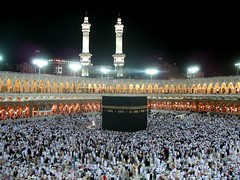
The Ka'aba is a semi-cubic building made of granite that was originally built by Abraham and his son, Ishmael, as a place of worship for monotheistic religion, but eventually fell into the hands of pagans. The pagans devoted Mecca's holy site to their tribal gods and placed figures of them within the structure and used it for their religious ceremonies.
Around 630 C.E. Muhammad and his followers claimed the Ka'aba as a site for Islamic worship after several years of battling with the pagan population of Mecca. Muhammad had the idols expelled from within the holy site and destroyed. At this time some of Muhammad's most difficult opponents converted to Islam along with the rest of the population in the area as the religion began to grow rapidly.
Today the Ka'aba still serves as a central focus for Islamic worship. Muslims all over the world orient themselves in a position that faces the holy site when they recite prayers five times daily. This practice brings a sense of unity to the people of the religion along with the Hajj, which is a pilgrimage to Mecca that is made by all Muslims that are physically and financially able at least once in their lifetime. During the Hajj, the pilgrims circle counter-clockwise together around the Ka'aba seven times among several other rituals that take place. This tradition can be seen in this video.